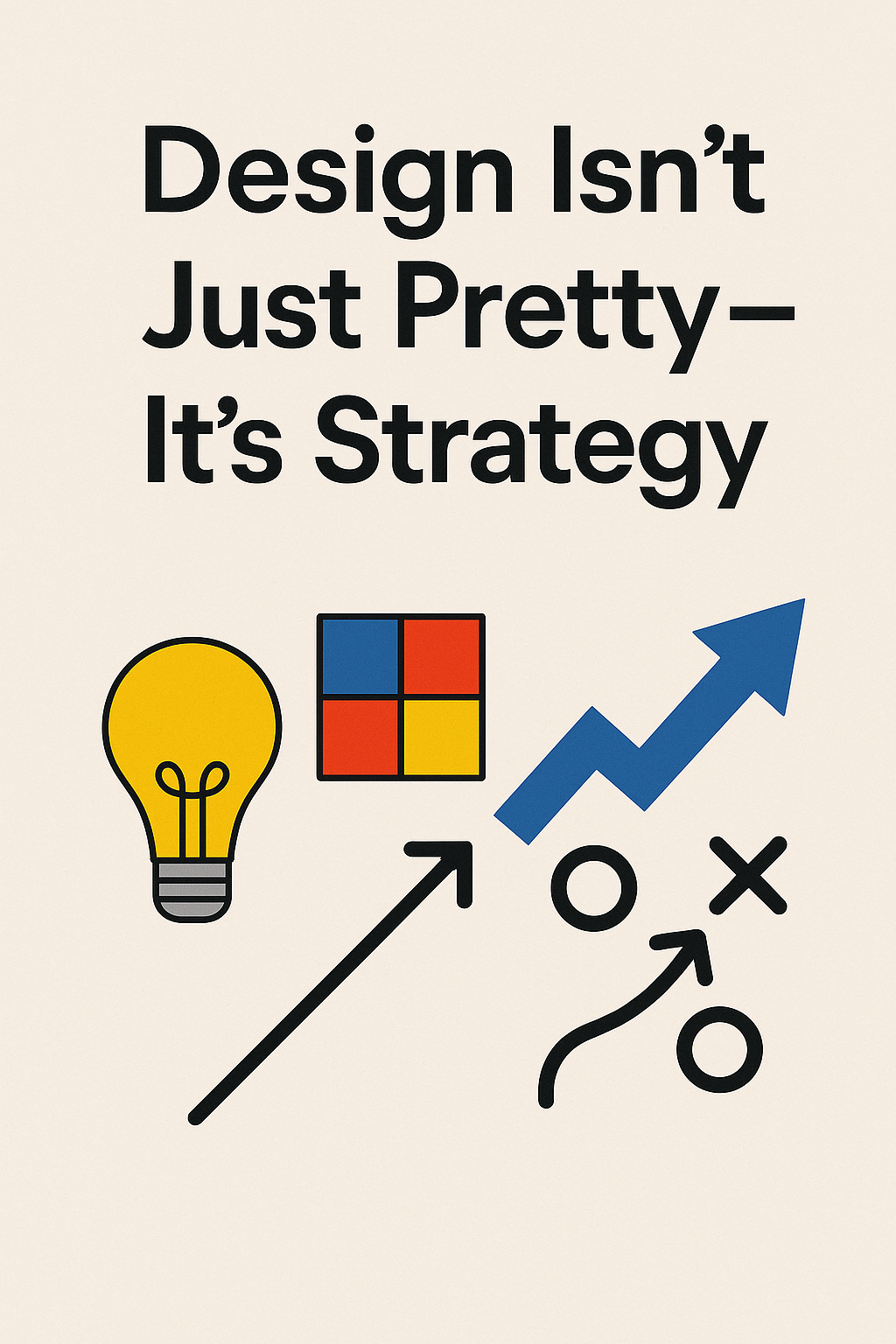Introduction: Rethinking Design as a Business Driver
Design is often misunderstood. To many, it’s about how things look—colors, logos, fonts. But great design isn’t just decoration. It’s how your product works, how users feel, and how your business grows.
For startups especially, design is strategy. It influences conversions, retention, user satisfaction, and even funding. It’s not the icing on the cake—it’s part of the recipe. When treated strategically, design becomes a growth engine, not a cosmetic fix.
The Misconception: Design as Decoration
Design vs. Aesthetics: What’s the Difference?
Aesthetics are part of design, but design goes deeper. It’s about structure, usability, and flow. A beautiful app that’s confusing to use is still bad design.
Why “Good Looking” Isn’t Always “Good Design”
You can copy Apple’s colors or Airbnb’s layout—but unless your product solves the user’s problem intuitively, it won’t matter. Good design makes products useful, not just stylish.
Common Myths About UI and UX Design
- Myth 1: Design is just for making things pretty.
- Myth 2: You can fix design later.
- Myth 3: Developers can “handle” the design.
In reality, design affects every touchpoint a user has with your product.
What Strategic Design Really Means
Design That Solves Real User Problems
Great design starts with empathy. What are users trying to do? What frustrates them? Every screen and element should help users accomplish their goals.
Aligning Design With Business Goals
Design should also serve your business outcomes—sign-ups, purchases, upgrades. It should guide users to take action with minimal friction.
Using Design to Guide Behavior and Decisions
From button placement to language and color, design nudges users. When used strategically, it increases trust, engagement, and satisfaction.
The Role of Design Across Product Lifecycle
In Discovery: Mapping User Journeys and Jobs to Be Done
Before a single line of code, designers help map user journeys—identifying key touchpoints, pain points, and workflows.
In MVPs: Prioritizing Clarity Over Complexity
Early products don’t need full branding—but they do need clear, usable flows that make it obvious what the product does.
In Growth: Optimizing User Flow and Retention
Design evolves with the product. As usage grows, so should your focus on optimizing drop-offs, boosting engagement, and reinforcing value.
Design and Product-Market Fit: A Hidden Link
Visual Cues That Enhance User Trust
Trust is visual. Poor design makes users hesitate. Good design makes them believe you know what you’re doing.
Reducing Friction in Onboarding and Usage
The faster users reach their “aha moment,” the better your retention. That’s a design challenge—how to make value obvious and effortless.
Making the Value Proposition Instantly Obvious
Users should understand what your product does and why it matters within seconds of landing on your site. That’s the job of layout, content, and design.
How Design Impacts Core Metrics
Conversion Rates and Click-throughs
CTA buttons, pricing pages, and landing layouts directly influence conversions. Design has a measurable ROI.
Retention and Churn Reduction
Poor UX leads to frustration and churn. Great UX increases satisfaction and stickiness.
Net Promoter Score (NPS) and Customer Satisfaction
User happiness is driven by how intuitive and satisfying your product feels—not just by features.
Examples of Strategic Design in Action
Slack: Friendly UX for Complex Workflows
Slack’s friendly tone, intuitive layout, and subtle animations make it easy to adopt—even though it handles complex workflows.
Duolingo: Gamified Flows That Improve Retention
By using playful animations, streaks, and progress tracking, Duolingo turns language learning into a habit.
Airbnb: Seamless Experience Built on Trust
Trust is core to Airbnb’s business. Its design supports verification, reviews, and clear communication—making strangers feel safe renting homes.
Collaborating with Designers: What Founders Should Know
Bring Designers in Early—Not Just at the End
Designers help shape the product from the start. They don’t just decorate the interface—they influence what gets built.
Share Product Goals, Not Just Wireframes
Designers need to understand why a feature exists, not just what it should look like. Share business context and user data.
Give Context, Not Just Color Preferences
Trust your designer’s process. Instead of saying “make it blue,” explain the emotion or message you want to convey.
The ROI of Great Design
Time Saved in Development and QA
Well-documented, consistent design systems mean fewer UI bugs and faster implementation.
Fewer Support Requests and Better Onboarding
If users understand your product immediately, they won’t flood your support inbox.
Brand Equity and Perceived Value
Well-designed products look more trustworthy, reliable, and premium—even if they’re just getting started.
Best Practices to Build Strategic Design Into Your Product
Conduct User Testing Early and Often
Testing doesn’t require hundreds of users. Even 5-10 usability tests can reveal huge insights.
Iterate Based on Data, Not Opinions
Use tools like Hotjar, Mixpanel, and user feedback to guide design decisions—not just team debates.
Maintain Design Systems for Consistency
Reusable components and style guides ensure your product scales without becoming a Frankenstein monster.
Conclusion: Strategy Starts With Design
Design is more than decoration. It’s how users experience your product. It’s how they trust you, understand your value, and stay loyal.
Treating design as a strategic function—not an aesthetic afterthought—can transform how your startup grows, competes, and thrives. Because in the end, design isn’t just pretty—it’s powerful.
FAQs on Strategic Product Design
1. Do I need a designer for my MVP?
Yes, even simple MVPs benefit from thoughtful UX that helps users complete tasks easily.
2. What’s the difference between UI and UX design?
UI is about the interface’s look and feel. UX is about how users interact and experience the product.
3. Can a developer handle the design?
Sometimes—but without UX thinking, you risk building something users don’t understand or enjoy using.
4. How do I know if my design is working?
Track metrics like bounce rate, activation, task completion, and support tickets.
5. How much should I invest in design?
At early stages, invest in clarity and usability—you don’t need fancy, just functional.
6. What tools do designers use?
Figma, Adobe XD, Sketch, InVision, and tools like Notion or Miro for collaboration.

